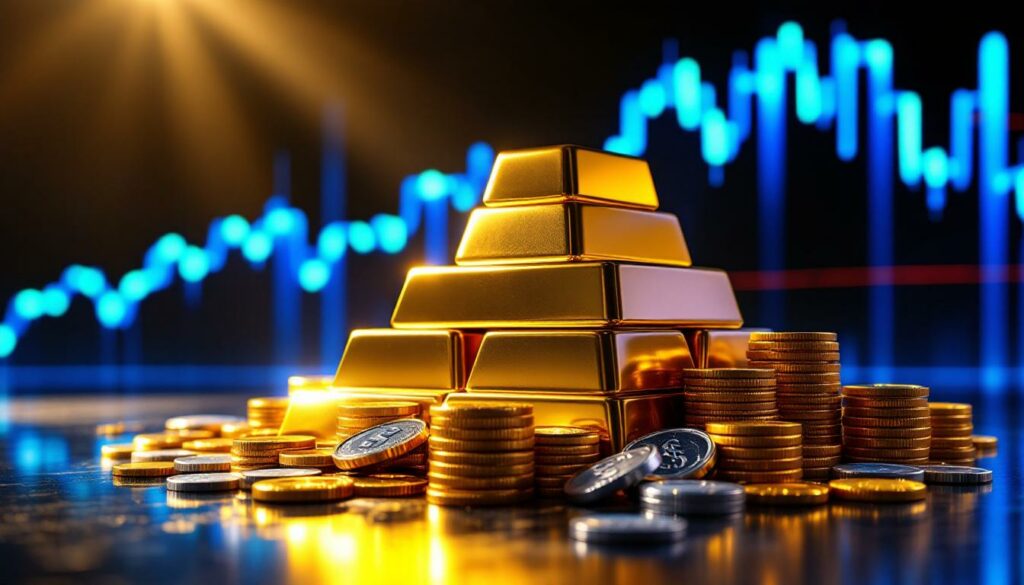What Are Precious Metals and Why Do They Matter During Inflation?
Precious metals—primarily gold, silver, platinum, and palladium—have served as monetary instruments and stores of value for thousands of years. Unlike fiat currencies that can be created through government policy, precious metals maintain intrinsic value due to their scarcity, industrial utility, and historical significance. This fundamental characteristic makes them particularly valuable during inflationary periods when paper currencies rapidly lose purchasing power.
During inflation, central banks typically increase the money supply, diluting the value of each currency unit. Precious metals and inflation have an inverse relationship, as metals cannot be "printed" and maintain relative scarcity regardless of monetary policy decisions. This creates a natural hedge against the wealth-eroding effects of inflation.
Understanding the Relationship Between Precious Metals and Inflation
Gold and silver have historically maintained purchasing power during periods when fiat currencies falter. This relationship exists because:
- Limited supply: The global production of precious metals increases by only 1-2% annually, unlike fiat currencies that can be created at will.
- Universal recognition: Precious metals are accepted globally, transcending national monetary systems.
- Industrial demand: Particularly for silver, platinum, and palladium, creating price support beyond investment demand.
- Central bank holdings: Major financial institutions maintain significant precious metal reserves as monetary backing.
As Michael Pachone, President at Can-Am Bullion, explains: "Gold and silver are the last things I will ever sell. They are your insurance policy." This perspective highlights how many investors view gold safe haven assets not merely as speculative vehicles but as fundamental protection against systemic risks.
The Historical Performance of Gold and Silver During Inflationary Periods
The 1970s stagflation era provides the most compelling modern example of precious metals performance during inflation. Between 1970 and 1980, while the U.S. experienced double-digit inflation:
- Gold prices rose from $35 to over $800 per ounce
- Silver increased from under $2 to nearly $50 per ounce
- Traditional assets like stocks and bonds delivered negative real returns
This historical precedent demonstrates how precious metals can thrive in environments combining high inflation with economic stagnation. Current economic conditions bear striking similarities to this period, with Pachone noting that "Precious metals perform best in high inflation and struggling economies like the 1970s… literally everything happening now is super bullish for precious metals."
Perhaps most telling is that central banks worldwide are purchasing gold at record gold highs, suggesting institutional recognition of gold's value during monetary uncertainty.
How Are Silver Markets Performing in Today's Economy?
Silver has emerged as a standout performer in precious metals markets, recently reaching 13-year highs around $36 USD per ounce. This price level represents a critical technical threshold that, if maintained, signals potential for continued upward momentum in the coming months.
The metal's dual nature—functioning as both a precious metal investment and industrial commodity—creates unique market dynamics. Unlike gold, which is primarily held as an investment or reserve asset, approximately 50% of silver production goes toward industrial applications ranging from electronics to solar panels, creating consistent baseline demand regardless of investment trends.
Recent Silver Price Movements and Technical Analysis
Silver's price action has demonstrated remarkable strength, breaking through several key resistance levels that had contained prices for over a decade. Market technicians note several important factors:
- 13-year price highs: Current levels haven't been seen since the aftermath of the 2008 financial crisis
- Critical $36 threshold: Maintaining prices above this level could signal further upward momentum
- Price projections: Technical analysis suggests $40 as an imminent target, with $50 possible by year-end
According to Pachone, these targets may actually be conservative: "$36 is a critical technical threshold… holding above it signals upward momentum. Silver could reach $50 by year-end—I'm being conservative." This outlook is particularly noteworthy given silver's historical volatility and the significant technical barriers it has already overcome.
Factors Driving Silver's Current Bull Run
Multiple converging factors are creating what some analysts describe as a "perfect storm" for silver pricing strategies:
- Central bank gold purchasing at record levels year-over-year, indirectly supporting the entire precious metals complex
- Weakening U.S. dollar, with the Dollar Index (DXY) falling below 100, reducing the relative cost of dollar-denominated metals for foreign buyers
- Growing industrial demand, particularly in green energy technologies where silver is essential for solar panel production
- Declining investor confidence in traditional financial assets amid economic uncertainty
- Physical supply constraints as mining output struggles to meet combined industrial and investment demand
Important Note: While silver has demonstrated significant upward momentum, precious metals markets remain volatile. Past performance does not guarantee future results, and investors should consider their individual circumstances before making investment decisions.
Why Are Treasury Markets Critical to Precious Metals Investors?
The U.S. Treasury market, despite receiving limited mainstream attention, represents perhaps the most significant factor influencing precious metals prices in the coming years. The interconnection between government debt, interest rates, monetary policy, and precious metals creates a complex but critically important relationship that investors must understand.
Treasury bonds, as the foundation of the global financial system and benchmark for "risk-free" returns, directly impact investment flows across all asset classes, including precious metals. When Treasury markets experience stress or unusual volatility, the ripple effects can dramatically alter the investment case for gold and silver.
The $9.2 Trillion Treasury Rollover Challenge
A monumental challenge facing financial markets is the approximately $9.2 trillion in U.S. Treasury bonds that must be refinanced (rolled over) by the end of 2025. This extraordinary refinancing requirement presents unprecedented challenges:
- New bonds will require higher interest rates to attract sufficient buyers in an already saturated market
- The sheer volume of new issuance will flood markets with Treasury securities
- Traditional large buyers of U.S. debt, including foreign governments like China, have shown decreasing appetite for Treasury securities
- The 10-year Treasury yield has already reached 4.5%, creating stress throughout the financial system
As Pachone explains: "The Treasury rollover is a bomb market… How do you sell $9.2 trillion when traditional buyers like China aren't interested?" This refinancing challenge could force difficult choices by monetary authorities, with significant implications for precious metals.
How Quantitative Easing Could Impact Precious Metals
Many analysts anticipate that the Federal Reserve will eventually be forced to implement new quantitative easing (QE) programs to manage the Treasury rollover crisis and prevent a collapse in bond prices. This monetary expansion would likely:
- Devalue the U.S. dollar further as new currency enters circulation
- Increase inflationary pressures throughout the economy
- Drive investors toward hard assets like precious metals as currency protection
- Create conditions similar to those that previously propelled gold and silver to record gold highs
"The Fed will have to print money via QE, devaluing the dollar and driving investors to metals," notes Pachone, highlighting the potential catalyst for the next major move in precious metals markets.
Disclaimer: The Treasury market outlook represents analysis based on current conditions. Future Federal Reserve policy decisions depend on multiple factors and remain uncertain. Investors should conduct their own research before making investment decisions based on potential monetary policy outcomes.
What Strategies Should New Precious Metals Investors Consider?
Entering the precious metals market requires thoughtful consideration beyond simply purchasing assets. The unique characteristics of gold and silver—including physical storage requirements, premium structures, and market dynamics—create additional factors that new investors must navigate.
Unlike traditional financial assets managed through standard brokerage accounts, precious metals investors must make decisions about form (physical vs. paper), storage, dealer selection, and timing. These choices significantly impact both security and potential returns.
Education First: Understanding Your Investment Rationale
For first-time precious metals investors, education should be the priority before making any purchases. Pachone emphasizes: "Educate yourself first—understand why you're buying metals and the difference between speculation and long-term preservation." This educational foundation should include:
- Understanding fundamentals: The economic and monetary factors driving precious metals markets
- Investment objectives: Clarifying whether you seek speculation, wealth preservation, or inflation protection
- Time horizon: Distinguishing between short-term trading and long-term holding strategies
- Form selection: Evaluating the pros and cons of physical metals, ETFs, mining stocks, and other exposure methods
New investors should thoroughly research the historical performance of precious metals across different economic scenarios to develop realistic expectations. This research should include both bull and bear markets to understand the potential volatility inherent in these assets.
Long-Term Perspective: Insurance Against Systemic Risk
Experienced precious metals investors typically view their holdings as financial insurance—assets they would sell last in a crisis. As Pachone advises, "Treat metals as insurance against currency devaluation, banking instability, and inflation."
This perspective frames gold investment strategies not merely as investments seeking returns but as protection against:
- Currency devaluation through excessive money creation
- Banking system instability during financial crises
- Geopolitical uncertainty affecting global markets
- Inflationary monetary policy eroding purchasing power
Practical implementation of this strategy might include:
- Establishing a core position in physical metals stored securely
- Adding to positions systematically rather than attempting to time market bottoms
- Viewing price declines as opportunities to increase insurance coverage at lower premiums
- Maintaining sufficient holdings in other asset classes for liquidity needs
Important Consideration: Currently, many middle-class investors are prioritising debt reduction over new investments, including precious metals. This practical reality highlights the importance of establishing solid financial foundations before allocating capital to any investment class.
How Does Market Manipulation Affect Silver Prices?
The silver market has long faced allegations of price manipulation through sophisticated paper trading mechanisms. Understanding these dynamics is essential for investors to develop realistic expectations and appropriate strategies when participating in precious metals markets.
Unlike most commodities, precious metals—particularly silver—exist in parallel markets: the physical market for actual metal and the paper market consisting primarily of futures contracts and derivatives. While physical silver follows basic supply and demand fundamentals, the price is largely determined in futures markets where contract volumes often vastly exceed available physical metal.
Understanding Paper Market Dynamics
The mechanics of potential price manipulation involve several key elements:
- Leverage ratio: Futures markets allow positions controlling thousands of ounces with minimal capital
- Contract volume: Daily paper trading can exceed a full year's physical mining production
- Concentrated positions: Large institutions can influence prices through significant paper positions
- Price "smackdowns": Sudden selling pressure can appear without fundamental justification
- Short-selling: Taking positions that profit from price declines can temporarily suppress prices despite strong physical demand
Pachone explains that institutions can force 6-7% daily price drops "without negative news," highlighting the disconnect that can occur between paper prices and physical market reality. "Large institutions manipulate paper markets via short-selling or 'smackdowns'… but physical supply constraints make this unsustainable long-term," he notes.
Will Manipulation Continue in the Current Market?
Despite silver's recent strength, investors should remain aware that market intervention remains possible. Financial institutions with access to virtually unlimited digital currency can still exert downward pressure on prices in the short term through the mechanisms described above.
However, several factors suggest manipulation may become increasingly difficult:
- Physical demand: Growing industrial and investment demand is removing physical metal from markets
- Supply constraints: Mine production limitations create natural price support
- Market awareness: Increasing recognition of manipulation tactics by retail investors
- Regulatory scrutiny: Growing attention to unusual price movements in metals markets
The sustainability of manipulation appears to be declining as physical reality eventually forces paper markets to align with supply-demand fundamentals. As Pachone suggests, while short-term price suppression remains possible, the gold price forecast increasingly reflects genuine scarcity and demand factors.
What Economic Indicators Support the Case for Precious Metals?
Several macroeconomic indicators currently signal conditions historically favorable for precious metals performance. These indicators, when viewed collectively, suggest potential for continued upward pressure on gold and silver prices as investors seek protection from deteriorating economic conditions.
Precious metals and inflation typically have a positive relationship during periods of economic stress—a scenario many analysts believe is currently developing. Understanding these indicators helps investors evaluate the fundamental case for precious metals allocation within a diversified portfolio.
Signs of Stagflation Emerging
Stagflation—the challenging combination of high inflation and economic stagnation—creates particularly favorable conditions for precious metals. Current indicators suggesting stagflationary tendencies include:
- Persistent inflation despite aggressive interest rate increases by central banks
- Weakening consumer spending as discretionary income diminishes
- Middle-class financial stress visible in credit card delinquencies and reduced savings
- Rising debt levels across government, corporate, and household sectors
- Declining economic growth metrics despite massive stimulus measures
Pachone observes that "Every economic indicator signals red flags—stagflation is emerging" and "Consumer spending is weakening despite central bank efforts." These conditions mirror aspects of the 1970s economic environment when precious metals delivered exceptional performance.
The Middle-Class Financial Squeeze
A key factor supporting the precious metals thesis is the financial pressure facing middle-class households. This demographic segment traditionally drives consumer spending but currently faces unprecedented challenges:
- Prioritising debt reduction over new purchases or investments
- Struggling to maintain previous consumption levels
- Facing higher costs for essential goods and services including housing, food, energy, and healthcare
- Lacking disposable income for investments of any kind
This middle-class squeeze creates a paradoxical situation where the case for precious metals and inflation protection strengthens while many potential investors lack capital to participate in the market. However, this same dynamic could eventually drive institutional allocation shifts toward metals as traditional consumer-driven investments underperform.
Economic Context: While precious metals often perform well during economic stress, they remain just one component of a comprehensive financial strategy. Investors should consider their complete financial situation, including emergency reserves and debt management, before allocating to any investment class.
How Are Retail Precious Metals Markets Responding?
The retail precious metals market serves as a valuable barometer of investor sentiment and economic conditions. Current patterns in this market reveal complex and sometimes contradictory signals about investor behavior and financial stress levels across different demographic segments.
Analysing these retail market dynamics provides insight into both the current state of precious metals investing and potential future price directions as broader awareness develops among mainstream investors.
Current Investor Behaviour Patterns
Precious metals dealers report several notable trends in the current market:
- New investors entering the precious metals market for the first time, often driven by inflation concerns
- Experienced investors strategically adding to positions during price corrections
- Unexpected selling pressure from existing holders needing liquidity for financial obligations
- Demographic divergence between affluent investors increasing allocations and middle-class holders forced to liquidate
Perhaps most surprising is what Pachone describes as an "anomaly" in the current market: "We're buying more gold and silver from our customers than we're selling, which is an anomaly." This unusual pattern suggests economic stress forcing some investors to liquidate metal holdings against their preference, potentially indicating broader financial pressure.
Mainstream Awareness and Adoption
Despite recent price increases, precious metals ownership remains relatively uncommon among mainstream investors. Most middle-class individuals have not participated in the recent price appreciation, suggesting potential for significant new demand if broader awareness develops. This represents both:
- An opportunity for early positioning before mass adoption
- A risk that broader economic conditions might prevent widespread participation
The lack of mainstream participation is evidenced by relatively modest media coverage of metals compared to other investments, limited allocation recommendations from conventional financial advisors, and continued preference for traditional financial assets among retail investors.
Pachone observes that this dynamic creates potential for explosive price movement if mainstream investors eventually seek precious metals exposure: "The middle class hasn't participated in this move yet. They're struggling with the basics right now, but if that changes, demand could overwhelm available supply."
What Could Trigger the Next Major Move in Precious Metals?
While precious metals have already demonstrated significant strength, several potential catalysts could accelerate price appreciation or trigger the next major bull market phase. Understanding these potential triggers helps investors prepare for possible market scenarios and adjust strategies accordingly.
The precious metals and inflation relationship responds to both monetary policy developments and broader financial system stability concerns. When multiple catalysts emerge simultaneously, historically this has produced the most dramatic price movements.
Potential Catalysts for Higher Prices
Several developments could accelerate precious metals appreciation:
- Official announcement of new quantitative easing programs to address Treasury market stress
- Significant stock market correction driving capital to safe-haven assets
- Banking system instability reminiscent of 2008 or 2023 regional banking concerns
- Further weakening of the U.S. dollar below key technical support levels
- Acceleration of central bank gold purchases beyond current record levels
Pachone identifies the most likely catalyst as monetary
Want to Identify the Next Major Mineral Discovery?
Discover why precious metals like gold and silver offer protection during inflation and how to capitalise on major mineral discoveries with Discovery Alert's proprietary Discovery IQ model. Visit the Discovery Alert discoveries page to understand how major mineral discoveries can lead to exceptional market returns and position yourself ahead of the market.




